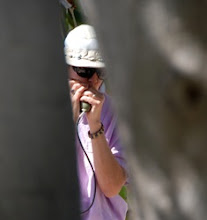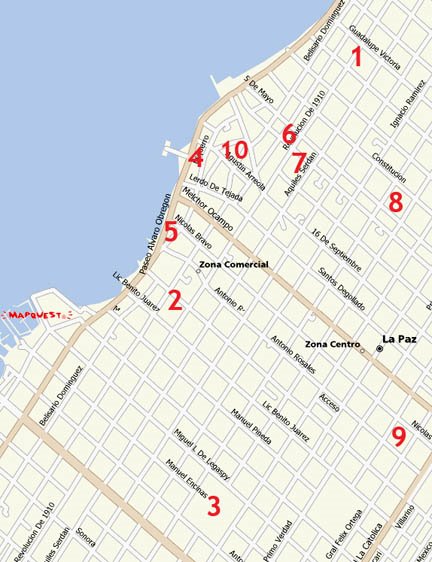
 The exhibit Tierra Ajena, work by “Gabo” Gabriel Rodríguez, runs until March 16 at Galería de Arte Carlos Olachea, Navarro and Héroes de Independencia, next to Teatro de la Ciudad. The opening is Feb. 22, 8 p.m.
The exhibit Tierra Ajena, work by “Gabo” Gabriel Rodríguez, runs until March 16 at Galería de Arte Carlos Olachea, Navarro and Héroes de Independencia, next to Teatro de la Ciudad. The opening is Feb. 22, 8 p.m.GABO IN A FOREIGN LAND
The artist “Gabo” Gabriel Rodríguez calls his new exhibit of paintings Tierra Ajena –Someone Else’s Land. As I learn in an interview with Gabo, that expression carries a basketful of reflections: everyday life defined as alien territory, a loner’s sense of humor, two castles and the heroism of a grandfather. Let’s begin with the grandfather.
FOREIGN LAND, COMMON DESTINY
Don José Guadalupe Romo Romo, Gabo’s maternal grandfather, lived in a village in the state of Aguascalientes in western central Mexico. The name of the village: Tierra Ajena.
FOREIGN LAND, COMMON DESTINY
Don José Guadalupe Romo Romo, Gabo’s maternal grandfather, lived in a village in the state of Aguascalientes in western central Mexico. The name of the village: Tierra Ajena.
It was during the Cristero War of 1926-1929, the armed uprising against the anti-Catholic Mexican government. Don José was giving protection to the Cristeros, and he allowed his house to be used for religious services.
One day, Gabo says, a traitor alerted federal troops. Don José did what he could to enable the parishioners to escape, then waited for the troops to arrive. A speedy trial ended in a sentence of hanging.
But in that rocky village on the plains, it took a long time to find a tree for the execution. On the first attempt, the hangman’s knot unraveled, sending the condemned man crashing to the ground. He got up and shook off the dirt. “Don’t be idiots,” he is reported to have said, before tying the knot himself and surrendering to his fate.
WHAT DOES 'TIERRA AJENA' HAVE TO DO WITH THIS EXHIBIT?
The story of his grandfather is a source of pride for Gabo and part of his own identity. Don José had come from Europe to this foreign land -- to a place actually named “someone else’s land.” Because of the war, Gabo’s mother was forced to move away; she, too, grew up in “someone else’s land.” Gabo feels that he, himself, lives in a place that is not his own.
WHAT DOES 'TIERRA AJENA' HAVE TO DO WITH THIS EXHIBIT?
The story of his grandfather is a source of pride for Gabo and part of his own identity. Don José had come from Europe to this foreign land -- to a place actually named “someone else’s land.” Because of the war, Gabo’s mother was forced to move away; she, too, grew up in “someone else’s land.” Gabo feels that he, himself, lives in a place that is not his own.
More than that, Gabo believes all of us live in someone else’s land. We are children of people who come from somewhere else. We are guardians of a world belonging to future generations. And we dream, he says, about becoming better people in our adopted home. Maybe that's why the exhibit bears the subtitle: Destino Común (common destiny).
Now Gabo tells me that – for all he has just said – there is, in fact, no direct relationship between tierra ajena and the exhibit. He means the title to be simply an invitation to reflect on the meaning of living in someone else’s land.
PEOPLE WHO HAVE ALREADY EATEN
PEOPLE WHO HAVE ALREADY EATEN
I ask Gabo what he would like people to know about this exhibit.
“Absolutely nothing.”
His art is not in the tradition of Diego Rivera, José Clemente Orozco and David Alfaro Siqueiros, Mexican muralists whose work carries social and political messages.
“No, a picture is a pleasure,” he says. “A picture is a digestive – a drink for after dinner. If there is no meal, you don’t want art. A picture is for people who have already eaten.”
Gabo’s paintings have been compared to those of Marc Chagall. They’ve also been described as “garish and thought-provoking, bizarre images from a fertile mind.”
In this exhibit, you may be reminded of Baja California’s famous pinturas rupestres, the prehistoric cave murals of human figures, four-legged animals, birds and arrows. “Even the creators of the pinturas rupestres came from elsewhere,” Gabo notes.
The artist is an animated talker. He widens his eyes, waves his hands, bobs and weaves in his seat. In conversation, he paints pictures with his body language. He is enjoying himself. In person and in his art, Gabo has a sense of humour.
There are artists whose work is cerebral, Gabo says, whose paintings concern themselves with rot, carnivores, enormous tongues. Here Gabo’s eyes bulge, his voice drops an octave. The playfulness is edged with sarcasm.
He has a problem with that artistic personality. “You want to take a picture home, hang it on your wall. You want something happy, something amusing. You’re not going to pay to be depressed. You are going to pay for pleasure. You say, ‘Why bring more problems into my house? I already have lots of those.’”
ALMOST LIKE GOD
Gabo is successful. Work in his gallery in Todos Santos commands a high price. He is not alone. In fact, he says, the art scene in Baja California Sur is exceptionally good, especially in Todos Santos, San José del Cabo and Loreto. He describes it as “a phenomenon” – thirty artists selling 1,500 paintings each year.
ALMOST LIKE GOD
Gabo is successful. Work in his gallery in Todos Santos commands a high price. He is not alone. In fact, he says, the art scene in Baja California Sur is exceptionally good, especially in Todos Santos, San José del Cabo and Loreto. He describes it as “a phenomenon” – thirty artists selling 1,500 paintings each year.
In the community of Todos Santos, home to many artists from the U.S., Gabo is a loner. The atmosphere is not all that convivial, he acknowledges. “It doesn’t surprise me because our countries have very different roots and cultures,” he says. “North Americans may not get along well with the Mexicans, we may not eat at the same table. But together, we are a phenomenon.”
In any case, he says, creating art is a solitary act for him: The true artist must produce art in the same way one goes to the bathroom. You have to be alone.
He tells me art is a sacred niche for him, where he can develop spiritually. It’s a quest for truth. “It is a language of feeling with colours and with forms that are feelings. And the success depends on the honesty with which one paints.”
An artist is a creator of spaces. He says he feels almost like God when he succeeds in his creations.
WHAT IS IT WITH GABO AND HIS CASTLES?
WHAT IS IT WITH GABO AND HIS CASTLES?
There is a flamboyance to Gabo. He signs his work GABO. He doesn’t use his full name. That’s because he grew up with so many other Gabriels: his father, his sister Gabriela and three more Gabriels in the family next door. His mother called him Gabo; the name became his artistic signature.
We are in the artist’s new studio in La Paz, where he has lived for most of the last 30 years. “Many people think you live in Todos Santos,” I say.
“In Todos Santos, they think I live in La Paz. In La Paz, they think I live in Todos Santos.”
I look up at the sky-high, convoluted ceiling. From the hills above La Paz, the turquoise peaks of this new studio are as easy to spot as the twin spires of the cathedral in the city’s main square. His gallery in Todos Santos has been compared to a castle and a Spanish mission. Some call it the “Church of Gabo.”
What is it with Gabo and his castles?
“I paint stars, I paint moons, I paint enormous spaces.” The earth, itself, is on a journey, he says, as it travels in the Milky Way. “The possibilities are very large. And so I always, in my own construction, want to reach toward the sky.”
After an hour with Gabo, I feel as if I, too, have been on a journey of twists and turns. The artist says his work bears no message, but asks us to reflect on the meaning of life as alien territory. He says his pictures are meant to amuse, but describes the act of painting as a spiritual quest for truth. He even says he converses with stones – at least, with the stones that became part of his studio in Todos Santos.
“I talked with the stones,” Gabo tells me, “and I asked them, ‘What do you want?’ And they said, ‘One day, we would like to know the heights.’ Because the stones never knew what it was like to be high up.”
And so, Gabo raised up his stones to be a little closer to the sky.


